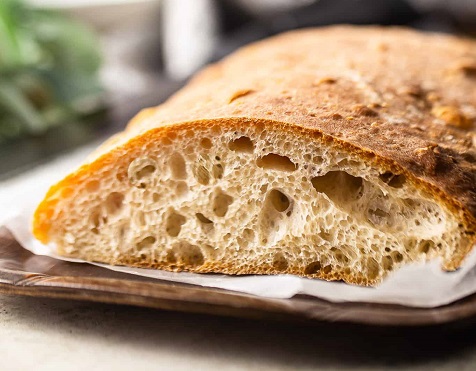Ciabatta Breads Recipe
Ciabatta bread, with its signature crisp crust and airy, open crumb, is a favorite among bread enthusiasts and sandwich lovers alike. Originating from Italy, this rustic bread is perfect for making paninis, bruschettas, or simply enjoying with a drizzle of olive oil.
Despite its gourmet appeal, ciabatta is surprisingly easy to make at home. Follow this step-by-step guide to create delicious homemade ciabatta bread that rivals any bakery offering.
Why Make Ciabatta Bread at Home?
Homemade ciabatta bread offers several advantages over store-bought versions. Freshness is paramount – nothing compares to the taste and aroma of bread straight from the oven.
Additionally, making ciabatta at home allows you to control the ingredients, ensuring there are no preservatives or artificial additives.
Plus, the process of baking bread can be a therapeutic and rewarding experience, filling your home with the comforting scent of freshly baked bread.
Ingredients for Ciabatta Bread
Before you start, gather the following ingredients:
- 4 cups all-purpose flour: Provides the structure for the bread.
- 2 teaspoons salt: Enhances the flavor.
- 1 teaspoon sugar: Feeds the yeast.
- 2 ¼ teaspoons active dry yeast: Leavens the dough.
- 2 cups warm water (about 110°F/43°C): Activates the yeast.
- 2 tablespoons olive oil: Adds richness and helps create a soft interior.
Step-by-Step Instructions
Step 1: Prepare the Sponge
A sponge (or preferment) gives ciabatta its characteristic flavor and texture. To make the sponge, mix 2 cups of the flour, 1 cup of warm water, and the yeast in a large bowl. Stir until well combined, then cover the bowl with plastic wrap and let it sit at room temperature for at least 12 hours, or overnight. The sponge should be bubbly and doubled in size by morning.
Step 2: Mix the Dough
In a large mixing bowl, combine the remaining 2 cups of flour, the salt, and the sugar. Add the sponge and the remaining 1 cup of warm water. Mix until a sticky dough forms. This can be done by hand or with a stand mixer fitted with a dough hook. The dough will be quite wet and sticky, which is normal for ciabatta.
Step 3: Knead the Dough
Kneading ciabatta dough requires a different technique due to its high hydration. If using a stand mixer, knead on medium speed for about 10 minutes until the dough is smooth and elastic. If kneading by hand, use the stretch and fold method. Stretch the dough upwards and fold it back onto itself, rotating the bowl 90 degrees after each fold. Repeat this process for about 10 minutes.
Step 4: First Rise
Lightly oil a large bowl and transfer the dough into it. Cover the bowl with plastic wrap or a damp kitchen towel and let it rise in a warm, draft-free place for about 1 ½ to 2 hours, or until doubled in size.
Step 5: Shaping the Ciabatta
Once the dough has risen, gently turn it out onto a well-floured surface. Be careful not to deflate the dough too much to preserve the air pockets. Divide the dough into two equal pieces. Gently shape each piece into a rectangular loaf by folding it over itself a few times. Place the loaves on a well-floured baking sheet or a piece of parchment paper.
Step 6: Second Rise
Cover the loaves with a floured kitchen towel and let them rise for about 45 minutes to 1 hour. The loaves should puff up slightly but will still be somewhat flat, which is characteristic of ciabatta.
Step 7: Preheat the Oven
While the loaves are rising, preheat your oven to 425°F (220°C). Place a baking stone or an inverted baking sheet in the oven to heat. Having a hot surface to transfer the loaves onto will help create a nice crust.
Step 8: Bake the Bread
Gently transfer the risen loaves onto the hot baking stone or baking sheet. Bake for 20-25 minutes, or until the ciabatta is golden brown and sounds hollow when tapped on the bottom. If you have a spray bottle, spritz the inside of the oven with water a few times during the first 5 minutes of baking to create steam. This will help develop a crisp crust.
Step 9: Cool and Serve
Remove the loaves from the oven and let them cool on a wire rack for at least 30 minutes before slicing. This allows the interior to set properly. Enjoy your homemade ciabatta with olive oil, as a base for sandwiches, or simply on its own.
Tips for Perfect Ciabatta Bread
- High Hydration Dough: Ciabatta dough is very wet, which is essential for its open crumb structure. Don’t be tempted to add more flour.
- Stretch and Fold Method: This technique helps develop gluten in a high hydration dough without traditional kneading.
- Use a Baking Stone: This helps create a crisp crust. If you don’t have one, an inverted baking sheet works too.
- Steam in the Oven: Spritzing water in the oven during the first few minutes of baking helps develop a beautiful crust.
- Be Gentle: When handling the dough, be gentle to retain the air pockets that form during fermentation.
Health Benefits of Ciabatta Bread
While ciabatta is often seen as a treat due to its delicious texture and flavor, it also offers some nutritional benefits:
- Complex Carbohydrates: Provides sustained energy.
- Low in Fat: A healthier choice compared to some enriched breads.
- Versatile Base: Can be paired with nutritious toppings like avocado, vegetables, and lean proteins.
Storing and Freezing
Store ciabatta bread at room temperature in a paper bag for up to 2 days to maintain its crisp crust. For longer storage, wrap the bread tightly in plastic wrap and aluminum foil, then freeze for up to 3 months. To thaw, leave the bread at room temperature, then reheat in the oven at 350°F (175°C) for 10 minutes.
Delicious Ways to Enjoy Ciabatta Bread
Ciabatta’s versatility makes it perfect for various culinary uses:
- Paninis: The ideal bread for grilled sandwiches.
- Bruschetta: Top with tomatoes, basil, and olive oil for a classic Italian appetizer.
- Dipping: Serve with olive oil and balsamic vinegar for a simple, delicious starter.
- Garlic Bread: Turn it into a garlicky delight by toasting with garlic butter and parsley.
Conclusion
Making ciabatta bread at home is a rewarding endeavor that brings the taste of authentic Italian baking to your kitchen. With its crisp crust and airy interior, ciabatta is perfect for sandwiches, appetizers, or simply enjoying on its own.
This easy-to-follow recipe and helpful tips will guide you to success, whether you’re a novice baker or an experienced one. So, roll up your sleeves, gather your ingredients, and get ready to bake delicious homemade ciabatta bread. Your taste buds will thank you!

